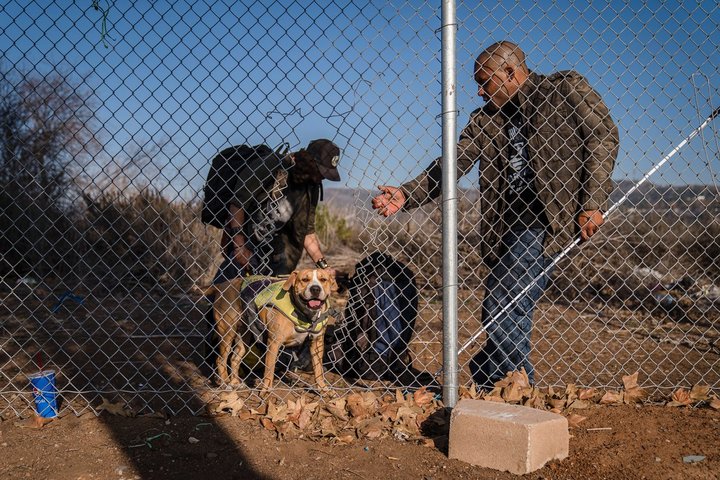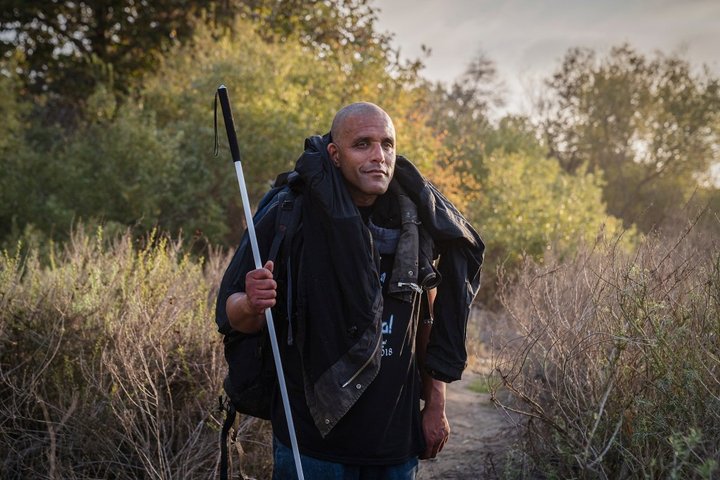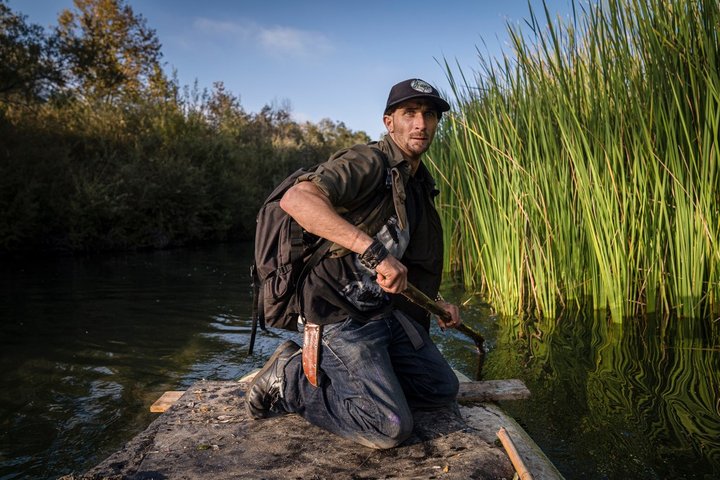
William Brown, right, and Josh Lowe with his dog near the encampment where they both were staying before it was cleared by Caltrans in San Clemente. Photo by Ariana Drehsler for CalMatters
###
The first time William Joseph Brown filled out a survey to try to get into permanent housing, he was living beside a highway. That was December 2019.
In late August this year, when California’s transportation agency cleared him from the same strip of land tucked behind the San Clemente off-ramp on the northbound Interstate 5, he still had nowhere to live.
Caltrans removed Brown and about 20 other campers due to the “immediate safety threat of fire,” as they were “using open flames to cook near dry vegetation,” a spokesperson told CalMatters.
The agency said six of those people were matched to permanent housing. Brown said he got a voucher for a hotel room for about a week, and then another, which recently expired.
But he’s still waiting on the permanent housing voucher he was promised two years ago. Brown said none of his friends exited homelessness since they were removed from the camp, either: “They’re just in a different place.”
“We were on the off-ramp because we were out of the way,” he said. “People don’t want to see homeless people. A lot of us were there because that was the last place to go.”

William Brown, 42 , in the woods in San Clemente on Nov. 6, 2021. Brown said he lost $1,000 worth of belongings while being removed from an encampment on Caltrans property and was left with only a backpack and bag. Photo by Ariana Drehsler for CalMatters
California is spending more than ever before on homelessness — $12 billion between 2021 and 2023 — which also means there’s more pressure to make an impact. The bulk of that money will go to creating more living spaces and providing mental health resources for people who are now on the streets.
But some of the money is being used by Caltrans in a ramped-up effort to move people like Brown off the state’s bustling freeways in the name of safety.
“We’ve got to deal with homelessness,” Gov. Gavin Newsom said at the 2021 California Economic Summit in Monterey on Nov. 9. “We’ve got to deal with cleaning the state, the streets, cleaning up our thoroughfares, our underpasses, our overpasses, removing graffiti, dealing with encampments.”
Reducing homelessness is top of mind for many voters. And it’s likely to be a big campaign issue in 2022, as it was for the Sept. 14 election on whether to recall Newsom.
But while it may be good politics to move homeless people out of visible public locations, experts say it’s just moving the problem somewhere else.
“Spending state money on harassing people who are struggling under the impacts of local, state and federal policy failures is counterproductive,” said Margot Kushel, director of the Benioff Homelessness and Housing Initiative at the University of California, San Francisco. “I would present the radical idea of taking the perspective of the people living there.”
There aren’t enough beds
The last time volunteers and local officials counted the number of people experiencing homelessness in California was on a January night in 2020. They came across more than 161,000 people, in and out of shelters. That is the largest number in the nation, but the tally is widely considered an underestimate, and it doesn’t take into account the economic devastation brought on by the COVID-19 pandemic that started two months later.
About 36% of those people had been homeless for at least a year, which means the other two-thirds were newly homeless, according to federal data.
Meanwhile, cities and counties across California reported last year a little more than 53,000 beds in either an emergency shelter or transitional housing — or fewer than one bed for every three people. In some areas, the ratio is as high as five people per bed; no county has at least one full bed per person.
There are, however, some shelter beds — in churches for example — that aren’t counted in these official statistics because they don’t receive any money from the federal government.
A lot more beds became available in California during the pandemic in hotel and motel rooms leased or bought by the state at a record clip. Project Roomkey has provided temporary shelter to more than 48,000 people during the pandemic, and Project Homekey temporarily sheltered thousands more across 94 hotels that created about 6,000 permanent housing units.
Funding for the latter program was tripled in the most recent budget, from $846 million to $2.75 billion. Another $2.2 billion over the next three years will go to create behavioral health facilities.
In Los Angeles, officials found that between the loss in warehouse-style shelter capacity brought on by COVID safety measures, and the gain mostly in motel rooms made available by the state, total shelter capacity in the city didn’t vary significantly between 2020 and 2021.
But advocates say achieving a one-to-one ratio on shelter beds for people shouldn’t be the ultimate goal. Running shelters can be very expensive, and while it treats the problem temporarily, it can be a dead end when there’s no permanent housing on the other side. The Los Angeles Housing Authority, for example, found it needed more than triple the existing permanent supportive housing supply to match demand.
Besides, many people say they don’t want to go into congregate shelters, where they often are not only exposed to substandard living conditions, but potential assault.
“If you offer traumatized people to be in a huge shelter where there can be violence, where there can be no end in sight, where your things will get stolen, or could get stolen, that’s not not really an offer,” Kushel said.
At Brown’s camp by I-5, he said he and two other campers were offered a shelter bed, but turned it down. He suffers from a degenerative eye condition that blocks his peripheral vision, and said he had his belongings stolen multiple times at shelters.
What’s in the budget for Caltrans?
The budget includes $1.1 billion for a project called Clean California, with most of the money going to litter pickup and beautification. Newsom has said it will add about 11,000 jobs over three years, with at-risk youth and people who were formerly homeless or incarcerated getting priority. Caltrans is also using a small portion of the funding to clear homeless encampments.
“We’ve got to deal with cleaning the state, the streets, cleaning up our thoroughfares, our underpasses, our overpasses, removing graffiti, dealing with encampments.”
— Gov. Gavin Newsom at Nov. 9 Economic Summit
“The situation with encampments in California is unacceptable,” Newsom said in a recent statement. “I refuse to accept the status quo — our fellow Californians suffering in tents, under highway overpasses, exposed to the elements, and living in unsanitary conditions.”
During the economic summit, the governor said that his office had identified 100 encampments as top priorities and was working with Caltrans to clear them “in a thoughtful and strategic way” — a promise he has made multiple times.
But so far his office and Caltrans have declined to identify the locations, citing privacy and security concerns for the campers.
“How are we supposed to know what’s happening with these resources?” asked Christopher Martin, policy director at Housing California, a nonprofit advocacy group. “It’s very behind closed doors, and I think that’s a little bit frightening because we need some accountability.”
Caltrans also got an additional $2.7 million this fiscal year for homeless coordinators to mitigate safety risks at encampments, clean trash and debris, and connect people living in these camps to support services and housing.
In a statement to CalMatters, Caltrans said it spent more than $15 million in the fiscal year that ended Sept. 30 and projects to spend nearly $36 million in the next year specifically on homeless camp cleanups. It conducted just 19 encampment relocations in all of 2020, when federal health officials advised against them during the pandemic. This year, Caltrans has completed 347 through mid-October.
When asked how the agency deals with the shortage of shelter and housing units, Caltrans officials said they “coordinate with cities and social service providers, which can connect people experiencing homelessness with services. However, on high priority encampments where an immediate threat to safety or to essential infrastructure has been identified, the department must proceed with the encampment clearing.”
At the same time, there’s $50 million in new grants to help local governments deal with encampments. The applications opened recently, and the money will be distributed next summer.
None of that money will fund encampment clearings, according to Russ Heimerich, a spokesman for the California Business, Consumer Services and Housing Agency. Instead, he said, grantees will get funds to provide services tailored to the needs of people in those camps.
Heimerich directed any questions about the Caltrans cleanups to the transportation agency, while Caltrans directed questions about the encampment service programs to the California Homeless Coordinating and Financing Council. Both declined multiple requests for phone interviews.
Martin said the apparent lack of coordination between the programs was “a little concerning.”
California’s state auditor in February raised concerns about a lack of coordination between the multiple agencies dealing with homelessness in California: “At least nine state agencies administer and oversee 41 different programs that provide funding to mitigate homelessness, yet no single entity oversees the State’s efforts or is responsible for developing a statewide strategic plan.”
The new programs raise a bigger question for Josh Barocas, an associate professor of medicine at the University of Colorado who studies homelessness and substance use: Why is transportation money going toward clearing homeless camps?
“It doesn’t actually take into account the long-term health effects of those being displaced and doing the displacement, and their future needs,” he said.
Through a computer modeling study that did not undergo peer review, Barocas found that in Boston, disbanding a homeless camp was more likely to drive up overdoses, hospitalizations and mortality.
“It’s what I would call social theater,” he said. “It’s showing your neighborhood that you are trying to do something by literally sweeping the problem away….The only way to actually fix this problem is to get at the social and structural issues that are perpetuating poverty, perpetuating homelessness in the city.”
While Barocas doesn’t believe in clearing encampments, he said there is value in continued community outreach, even when the housing isn’t there yet. “Bringing resources to where people are, and literally meeting them where they’re at, never loses utility,” he said.
“It’s what I would call social theater. It’s showing your neighborhood that you are trying to do something by literally sweeping the problem away.”
— Josh Barocas, an associate professor of medicine at the University of Colorado who studies homelessness
Eve Garrow, a homelessness policy analyst and advocate at the ACLU of Southern California, said many of the people now camping alongside California’s highways were originally in safer spots such as parks and restrooms. But they’ve moved into the fringes because of law enforcement harassment, often brought on by calls to service made by their housed neighbors.
“The answer is simple,” she said. “Stop criminalizing people.”
In a recent report, Garrow and her colleagues argue housing status should be a protected social group, a policy Martin’s group and the Western Center on Law and Poverty hope to advance in the Legislature’s next session.
Seeking stable shelter
Brown, who is 42, said he had worked with several county health workers to get on the waitlist for a permanent housing voucher, but all of them had since quit. “It just seems like nobody can even give me an answer as to why it’s not moving forward,” he said.
The voucher would subsidize Brown’s housing so he has to spend only a third of his disability check on rent. But he’ll still need to find a landlord willing to rent to a man who’s been homeless for more than five years.

Josh Lowe, 32, made a raft out of longboards and wood to cross the San Mateo Creek and reach where he has been staying in San Clemente. Lowe moved to the woods with his dog after an encampment on Caltrans property was removed on Aug. 27. Photo by Ariana Drehsler for Calmatters.
Eventually, he wants to be able to host his grandmother, which he couldn’t do on the side of a freeway. He also wants a cure for his vision; he learned about a clinical trial when he was living in the camp, but said it was very difficult for him to consider the option if he had to take medication, as it would likely get stolen. And he wants to stop worrying about getting his stuff stolen every night, when he can barely see.
Since getting kicked out of the camp, Brown connected with another service provider who’s scheduled to call him to sort out his case. Staying in a hotel with his friend, Megan, provided some much-needed stability. “I got very used to that, and then we were told we had to leave.”
Brown and three of his fellow campers wrote a letter urging elected leaders, public officials, and service providers involved in the camp clearing to be honest about the plight of many homeless people:
“Admit that the process of getting assistance is lengthy, that there is not enough housing for everyone who qualifies for it, and that there are people on the street who do want help and are doing what they’re supposed to do to receive it.”
###
CALmatters.org is a nonprofit, nonpartisan media venture explaining California policies and politics.
CLICK TO MANAGE